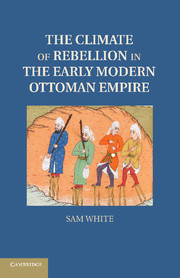Book contents
- Frontmatter
- Contents
- Acknowledgments
- Preface
- Glossary of Ottoman Terms
- Maps
- Introduction
- Part I An Imperial Ecology
- 1 Regions, Resources, and Settlement
- 2 Growth and Its Limits
- 3 Disasters of the Late Sixteenth Century
- 4 Land at The Margins
- Part II The Little Ice Age Crisis
- Part III Ecological Transformation
- Conclusion
- Bibliography
- Index
- References
4 - Land at The Margins
Karaman and Larende
Published online by Cambridge University Press: 05 February 2012
- Frontmatter
- Contents
- Acknowledgments
- Preface
- Glossary of Ottoman Terms
- Maps
- Introduction
- Part I An Imperial Ecology
- 1 Regions, Resources, and Settlement
- 2 Growth and Its Limits
- 3 Disasters of the Late Sixteenth Century
- 4 Land at The Margins
- Part II The Little Ice Age Crisis
- Part III Ecological Transformation
- Conclusion
- Bibliography
- Index
- References
Summary
By the late 1580s, the empire faced systemic threats to its stability and the functioning of its provisioning systems. However, the crisis and rebellion that would sweep Ottoman lands in the following decade was also rooted in the problems of one particular region: the province of Karaman in south-central Anatolia, especially its southeastern district of Larende. In order to understand how the crisis broke out here in this poor, inland province rather than in one of the major urban or agricultural centers of the empire, this chapter takes a closer look at Karaman's peculiar history and geography. A relatively late and difficult conquest, Karaman had once been the seat of an independent empire and had long resisted Ottoman rule. By the late sixteenth century, this region of south-central Anatolia also exemplified the worst effects of population pressure and economic turmoil in the empire, creating an explosive situation that would blow up in the Celali Rebellion of the 1590s.
- Type
- Chapter
- Information
- The Climate of Rebellion in the Early Modern Ottoman Empire , pp. 104 - 122Publisher: Cambridge University PressPrint publication year: 2011

